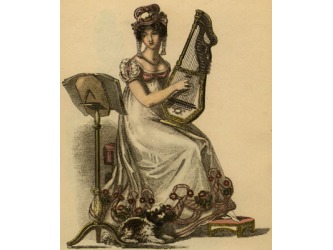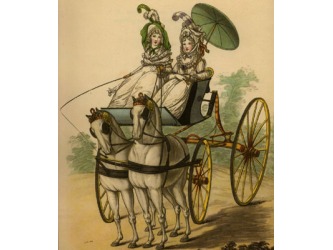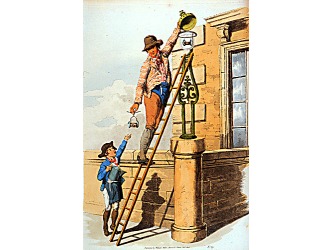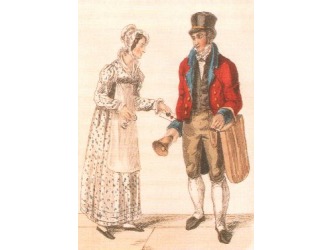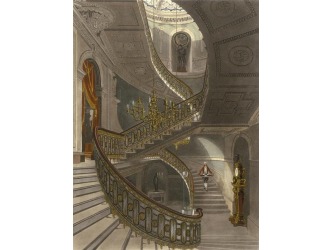Skating Party
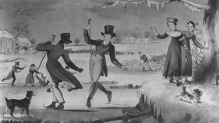
Other than walking and riding, there were few outdoor activities that a woman could do in Regency England, but ice skating was one of them. Although this picture shows only the two dandies skating while their female companions look on, women did skate, often on the arm of their suitor. Obviously, the two men in this picture are trying to impress the ladies. They are in their best clothes, and they must have been freezing!
Elizabeth looking at Darcy's portrait at Pemberley
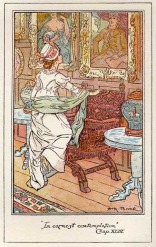
At the time Jane Austen had Elizabeth Bennet visiting Pemberley, the Darcy estate, there were no public art museums in Great Britain. Those wishing to view paintings and sculptures of the Masters would visit England's great estates as well as the extensive parkland surrounding their magnificent manor houses. Middle-class travelers could visit Blenheim, the ancestral seat of the Churchills, or Chatsworth, one of several homes of the Dukes of Devonshire, among many others. The first National Gallery in England would not open until 1824, seven years after Austen's death, at 100 Pall Mall, in the former townhouse of John Julius Angerstein, a Russian emigre, banker, and art collector, who had died the previous year. It was small, hot, crowded, and a national embarrassment when compared to the Louvre in Paris, but it was a start.
Not discussed in polite company
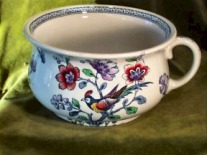
If you think standing in a very long line at a sporting events or concert to get into the women's rest room is inconvenient, imagine if there was no rest room at all. In the backstory for the 2003 film adaptation of Pride and Prejudice, it was noted that there were no indoor facilities, male or female. As a result, a woman had to give a lot of thought to what she drank before and during a dance, such as the ball that Charles Bingley hosted at Netherfield Hall. I assume that most women judiciously sipped their punch throughout the evening. Of course, for the men, a nice bush would suffice. Pictured at right is a very pretty chamber pot from the Regency Era.
Circulating Library
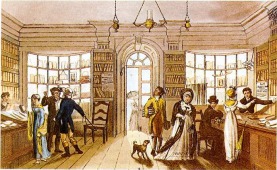
During the Regency Era, books were very expensive, and few families, other than the very rich, were able to afford the cost of an extensive library. A solution to this problem was the circulating library. The first known lending library was established in the Strand in London in 1730 and was run by Mr. Wright, a bookseller. The idea was very popular, and by the beginning of the 19th Century, the number of libraries had grown to 26 . With an increase in literacy, these lending libraries proved to be an affordable way for people to read books. There was a flat charge for the initial subscription, and then a small fee would be charged for each book checked out. One of the more popular books of the Regency Era was Maria Edgeworth’s Tales of Fashionable Life and, I’m sure, The Complete Works of Jane Austen.
Seaside Bathing
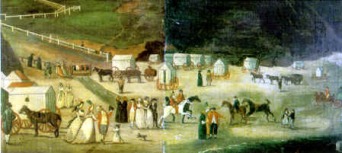
From the 18th Century on, bathing resorts multiplied, especially along England’s southern coast. They included Brighton, Ramsgate, and Eastbourne, all mentioned in Austen’s works. In addition to enjoying the “bracing sea air,” people could bathe in the always chilly waters of the Channel by using a bathing machine (pictured at left). In order to assure a woman’s privacy, there were designated areas for members of each sex. After the bather entered the bathing machine, he/she would change out of their street clothing and into their bathing costumes, and then the machine would be rolled into the water. Some resorts hired “dippers,” who were strong and hardy souls who would help the bather into the sea and might possibly push a person into the water to enhance the bathing experience. More information is available at: http://www.absoluteastronomy.com/topics/Bathing_machine.
Regency Fashion
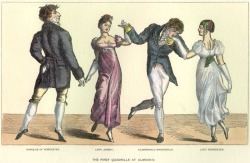
With the end of the Napoleonic wars in 1815, French fashion crossed the Channel and became all the rage in England. In most film adaptations of Jane Austen's novels, the women are wearing the high-waisted Empire dress, but when Jane first came into society, the waistline would have been much lower. However, during her lifetime, the waist crept up, inch by inch, until it was directly under the breasts. White was the color of choice because it indicated that the lady was wealthy enough to wear a light-colored dress that would require cleaning or replacement. Men's fashion was influenced by the Regency dandy, Beau Brummel, and included breeches, dark waistcoats, and jackets with neck cloth. These early decades of the 19th century saw glimpses of the Industrial Revolution which was just on the horizon. Men of science, industry and trade were making their mark, and because of their wealth, were being received, albeit reluctantly, into the homes of the landed elite. These changes made possible the Darcy/Bingley friendship
The London Season
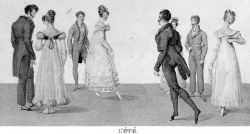
To reach the very top of London's elite society, it was necessary for an individual to secure a voucher to Almack's Assembly Rooms during the busy "season," a time when a whirlwind of activies took place in "town" (London). The Wednesday night balls featured simple repasts and lemonade (to avoid the excessive drinking so rampant in England's upper classes). A governing board made up of a group of ladies known as the haute ton determined who would receive these vouchers. Pictured above are dancers at Almack's doing the newly-introduced "quadrille." This sketch was made in the 1820s when men's fashion was at a crossroads. Note two dancers are in breeches while the other two are in trousers. Would Mr. Darcy and his middle-class wife have been included on the guest list? If it was up to Sarah Villiers, the Countess of Jersey, probably not. She was disliked, but feared, and as long as she was the Regent's mistress, she usually got what she wanted. Sarah is pictured below (the second from the left) in "Regency Fashion."
Letter Writing in Austen's Time
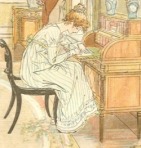
According to Joan Klingel Ray in Jane Austen for Dummies, "Letters in Austen's day looked like little books of folded paper containing four pages. On page 4, the back page, the writer left a rectangular space blank for the address..., and the addressee paid the postage due on the letter." This created a financial harship for some authors, especially those with enthusiastic female admirers, as was the case with Sir Walter Scott. Scott usually paid out more than 150 pounds a year for his correspondence, which I would estimate in today's money to be at least $1,000. The letter carrier with his leather mailbag would announce his arrival by ringing a bell. In many towns, mail was picked up at a local store or at a coaching inn where the mail coach would stop. In 1840, the Uniform Penny Post made its debut throughout the United Kingdom, and a postage stamp known as the Penny Black allowed the sender to prepay the cost of the post. But those changes went into effect 23 years after Jane's death. Jane's letters and business correspondence would have been written with a quill pen, which was constantly in need of sharpening and repair, and with ink that she may have made herself. It was a slow messy process, and just think how many drafts she wrote before perfecting her novels.
Brighton Pavilion - George IV
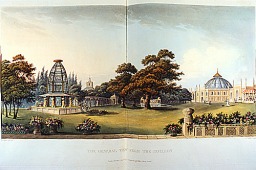
When Jane Austen wrote her first draft of Pride and Prejudice in the mid 1790s, George III was on the throne. By the time she published the novel in 1813, George III was in seclusion at Windsor Castle because of a mental/physical disorder, and his son was serving as Regent in his absence. The Regency Era saw great changes in London, most notably in its architecture, including Cumberland Terrace and Carlton House, the London home of the Prince Regent, whose size matched the Regent's ego, and was paid for by the British nation. Pictured at left is the Pavilion that George IV built in Brighton. Construction of the Pavilion as it exists today began in 1815, only two years before Austen's death, so this is not the Brighton of Lydia and Wickham (1813).
George IV/The Regent, Jane Austen Fan
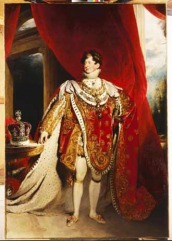
In 1811, the British Parliament passed “The Regency Act” which transferred power from George III to his son, the Prince of Wales. This legislation was necessary because the king was believed to be mad as a result of a recurring malady that was later identified as porphyria. The Act declared that until such time as the monarch regained his wits the Prince of Wales would rule Britain and its expanding empire. Unfortunately for the king, but fortunately for his son, George III never did recover and spent his remaining nine years in seclusion at WindsorCastle. While the Prince of Wales had been waiting in the wings for his father to either die or to be found insane, the future George IV had been busy accumulating enormous debts, acquiring expensive mistresses, launching elaborate building projects and eating and drinking to excess. By the time of his ascendancy, the Prince had established himself as a mainstay of the tabloid press and a favorite of caricaturists who portrayed him as an elegantly dressed stuffed sausage. When not planning or attending balls and fetes or being fitted for a new uniform to display his elaborate collection of unearned military decorations, the Prince did have his quiet moments. At the end of a long day of self-indulgence, he would kick back with a good book, and one of his favorite authors was a writer who identified herself in her first novel, Sense & Sensibility, as “A Lady,” and in her second novel, Pride & Prejudice, as “The Author of Sense & Sensibility,” but who was to become known to posterity as Jane Austen.
Napoleon and Wellington
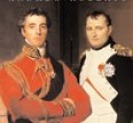
Between the time Sense and Sensibility was published in 1811 and Pride and Prejudice in 1813, the epic retreat of Napoleon and his forces from Russia had taken place (think Tchaikovsky's "1812 Overture" and Tolstoy's "War and Peace"). Jane Austen had two brothers (both admirals) in the fight, but you would never have known from reading Jane's novels that Euope was being ravaged by French armies and the Allied armies fighting them. The presence of the militia in Meryton exists in isolation when, in fact, the regiment would have been encamped near Longbourn because of its proximity to London and a fear of a French invasion. Col. Fitzwilliam is an officer in the regular army but seems to have no military responsibilities. In reality, the colonel would probably have been fighting with Wellington's forces in the Peninsular Wars in Spain. In 1815, Napoleon was exiled to the remote Atlantic island of St. Helena and peace returned to Europe. However, none of these epic events creep into Austen's Pride and Prejudice. She wrote about what she knew best: her neighborhood and its inhabitants. Wellington could take care of Napoleon; Jane would see to Hertfordshire.
In 1811, the British Parliament passed “The Regency Act” which transferred power from George III to his son, the Prince of Wales. This legislation was necessary because the king was believed to be mad as a result of a recurring malady that was later identified as porphyria. The Act declared that until such time as the monarch regained his wits the Prince of Wales would rule Britain and its expanding empire. Unfortunately for the king, but fortunately for his son, George III never did recover and spent his remaining nine years in seclusion at WindsorCastle.
While the Prince of Wales had been waiting in the wings for his father to either die or to be found insane, the future George IV had been busy accumulating enormous debts, acquiring expensive mistresses, launching elaborate building projects and eating and drinking to excess. By the time of his ascendancy, the Prince had established himself as a mainstay of the tabloid press and a favorite of caricaturists who portrayed him as an elegantly dressed stuffed sausage.
When not planning or attending balls and fetes or being fitted for a new uniform to display his elaborate collection of unearned military decorations, the Prince did have his quiet moments. At the end of a long day of self-indulgence, he would kick back with a good book, and one of his favorite authors was a writer who identified herself in her first novel, Sense & Sensibility, as “A Lady,” and in her second novel, Pride & Prejudice, as “The Author of Sense & Sensibility,” but who was to become known to posterity as Jane Austen.
One of Jane’s most ardent supporters was her brother Henry. Despite being cautioned by his sister that she did not want her identity known, Henry could not help but brag about his younger sister’s success, especially when the very popular Pride & Prejudice went into its third printing. It was Henry, from his sickbed, who successfully negotiated her agreement with John Murray, Lord Byron’s publisher, for her fourth novel, Emma. After an agreement had been secured with Murray, Jane went up to London to see if she could expedite the printing of her book. During her stay, she was contacted by Rev. James Stanier Clarke, the Regent’s librarian. His Royal Highness had learned that Jane was in town from his physician who also happened to be her brother Henry’s doctor.
Rev. Stanier invited Jane to tour Carlton House, the Regent’s opulent London residence. Putting aside her “hatred” for the Prince because of his debauchery and ill treatment of his wife, Princess Caroline, Jane accepted the invitation. During her tour, Stanier told Miss Austen that the Prince had a set of her novels in each of his many residences and that, “by permission of His Royal Highness,” she was “at liberty to dedicate any future novel to him.” Jane immediately recognized the commercial value of such a dedication, but she also used this information to get her printer to expedite the printing of her novel. Once acquainted with the Prince Regent’s interest, Jane had her proofsheets.
On December 23, 1815, the Morning Chronicle announced that “Emma: A Novel in Three Volumes by the Author of ‘Pride and Prejudice,’ Etc., Etc.” was now available. The dedication as written by Jane, “Dedicated by permission to HRH The Prince Regent,” was embellished by the publisher, and in unctuous prose worthy of Mr. Collins, the wording as it appeared that December morning read: “To His Royal Highness, The Prince Regent. This work is, by his Royal Highness’s permission, most respectfully dedicated by His Royal Highness’s dutiful and obedient humble servant, The Author.”
Did the Prince Regent’s notice of Jane Austen’s writings have any effect on the success of Emma? It is impossible to know. What we do know is that Emma sold more copies in its first run than any of her three previous novels.
Emma was the last novel to be published in Jane’s lifetime. The woman who had given the world Pride & Prejudice remained unknown to the general public until a year after her death in 1817 when her brother Henry wrote a biographical preface to Northanger Abbey and Persuasion. Known or unknown, Jane Austen’s legacy is a body of work that has delighted hundreds of thousands of readers from all walks of life and at least one prince.
